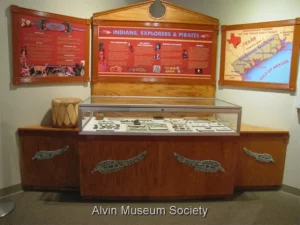
Indians, Explorers and Pirates (2:13)
The Karankawa Indians were a primitive tribe that lived along the Texas coastal area. These Indians were unusually tall, about 6 feet, used bear grease and mud to protect themselves from mosquitoes, and made rudimentary pottery.
The Karankawa migrated throughout the area with no permanent housing. They are often described as cannibalistic but they only consumed the flesh of the enemies to obtain their strength.
The artifacts shown (arrow points, spear points, shells and pottery shards) were found in their midden mounds (garbage dumps). There were midden mounds found in the Goose Creek, Mustang Bayou, and Chocolate Bayou areas.
The pottery shards with holes were from broken pottery that was laced back together and reused. The arrow and spear points in the center were donated by Grace Ward Harby who found them along Mustang Bayou as a child. The European trade beads, dating from the mid 1800’s, belonged to the donor’s great-great grandmother, a Native American. The Karankawa disappeared in the mid-to-late 1800’s.
The pot, arrow, hatchet, and awl are representations of tools probably used during this time. They are not artifacts.
The first explorer in this area was a Spaniard, Cabeza de Vaca. He was shipwrecked on Galveston Island in 1528 while in route to Mexico. He was captured by the Karankawa and spent five years with them before escaping and retuning to Spain.
Because of his misdeeds, the pirate, Jean Laffite was expelled from New Orleans in 1817. Lafitte, with about 1,000 others, came to Galveston Island. They foraged the local area around here for about 1 ½ years to secure wood, food and water (there was no fresh water in Galveston). It is said that they buried treasure in our area. One band of the pirates went to Louisiana and attacked a plantation. Because of this event, the United States forced the pirates to leave Galveston. They moved to the Caribbean where both Jean Laffite and his brother Pierre died within 1 ½ years.
